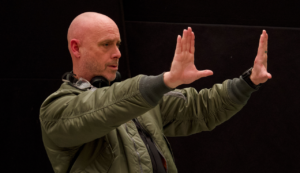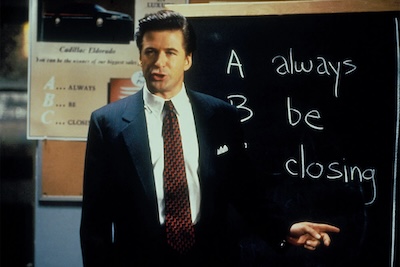A bright, blue sky welcomes us into Robert Moniot’s The Ice Cream Man, but it is one of the warmest images we will see throughout the shortlisted Live Action Short Film contender. As one family basks in the prospect of a new life, a fleet of ships zoom over the beach on May 10, 1940–the day that Germany invaded the Netherlands. Can hope stay alive as we witness the world changing before our very eyes? Moniot’s film is a new introduction to a slice of history unknown to many of us.
Have you ever heard of Ernst Cahn? We will never know every single story of the ravages of World War II, but Moniot’s film hones in on one man who we all should have learned about by now. Cahn was the first resistance fighter in The Netherlands to be killed by the Nazis. Originally, Moniot thought the scope would fill the frames of a feature-length film, but in 2022, he opted to enter the Claims Conference’s Emerging Filmmaker contest and won.
“My wife is a United States diplomat who used to work in Hollywood, and one day she decided that she would rather save the world,” Moniot says, admiringly. “I made the wisest decision of my life and I asked her to marry me, and we’ve been on the road for fifteen years now. She was stationed at The White House and we were supposed to be there for two years. The State Department called and asked if we could go to The Netherlands, and I honestly didn’t know anything about that country at that time. I found out the exact house we were staying in and I Googled the closest beach, and this gorgeous picture of The North Sea popped up. A box in the corner said that this was the location where Nazis executed 300 resistance fighters during the war. As a filmmaker, I got this image in my head of a man with his hands tied behind his back in front of a firing squad with a blindfold on. That’s when I found out that the Nazis executed the most popular man in town, because he owned an ice cream parlor.
I found a picture of him–this cigar-smoking, wine-swilling happy guy, and he happened to be Jewish. At first, it didn’t make sense with what I learned when it came to the Nazi resistence, and then I found out that it was at the hands of Klaus Barbie, who some consider to be the most sadistic Nazi to ever walk the face of this earth. He targeted Ernst, captured him, and tortured him for ten days. As if that wasn’t enough, his arrest led to the this series of events that culminates with Dutch citizens creating the largest anti-Nazi protest of the war. How was this not a movie already? How did I not learn about this in school?”
 Is our educational system failing young people when it comes to the atrocities of World War II and conflict in general? Moniot touches on how filmmaking can be one of our biggest tools when it comes to generating an empathy machine.
Is our educational system failing young people when it comes to the atrocities of World War II and conflict in general? Moniot touches on how filmmaking can be one of our biggest tools when it comes to generating an empathy machine.
“Schindler’s List made me feel when it came to the Holocaust rather than reading about it,” he says. “JFK made me angry and determined to find the truth. Movies always do that. if this could be a tool that teachers could use, especially now wih everyone being so insular when it comes to what is being taught and social media ravaging everyone’s lives. I felt like this was put on my plate for a reason, and I was supposed to go along from the ride.”
At the heart of The Ice Cream Man is Noah Emmerich, an actor of unflinching honesty. He doesn’t focus on Cahn’s goodness, but acknowledges his confusion over what is happening in his own backyard. We feel this man’s love for his family, but there is a fire flickering across his face. When you look closely, you can see it burning in his eyes.
“One of the reasons that I desperately wanted him for this is that even when he’s playing a shit, you still love the guy,” he says. “He just has something in his character–in his being–that I’ve always been incredibly drawn to. Even before I knew him. In a short film, I only have about thirty seconds to establish who this guy is, so you care about what is going to happen to him. He was the person that I wanted to do it, and, at first, he didn’t think he could do it since he was so busy. After I talked to him about it on the phone, he called me back, and he asked if I knew about his dad. In 1936, his father and his aunt fled Nazi Germany, moved to Amsterdam and lived around the corner from the ice cream parlor. Noah’s aunt was classmates with Anne Frank, and Noah’s family managed to get out. That sealed the deal for him.
He was very concerned about getting Ernst correct. I had worked with Noah before, but I had never directed him. I asked him how he wanted to work, and he’s such an incredibly intelligent and cerebral actor. He likes to be quiet with the material to find what he needs and wants. It’s a little intimidating for a young director like me to work with somebody like that because he know what he wants so clearly. We kept asking ourselves, and each other, if what we were portraying in the film would really happen in real life. That’s how we approached it.”
These coincidences kept happening. Moniot devoured every piece of research he could find, and, even when he thought he hit a dead end, another magical moment would happen.
“I couldn’t find the descendents of Ernst Cahn when this first started–it was like they didn’t want to be found,” Moniot says, “We got a fiscal sponsorship agreement with Film Independent and used their 5013c status to raise money to shoot the film after we won the Claims Conference grant and continued to raise money. You try to raise off of what you shot, essentially, but that ended up helping us in the end. After we shot a bunch, the movie wasn’t finished and the strikes were beginning to take shape, and the Cahn family read an interview that I had done. They found us and started telling us stories that weren’t in the history books, including that amazing scene where Ursula visits Ernst in prison before he was executed. That really happened, and I wouldn’t have known it if I didn’t meet the Cahn family.”
 When it looks like Cahn might not survive the torture he is subjected to, his wife Ursula appears in the doorway of his prison cell. Is she a dream or a vision? There is an ethereal element to her presence, but Moniot informed me that the exchange between them actually happened.
When it looks like Cahn might not survive the torture he is subjected to, his wife Ursula appears in the doorway of his prison cell. Is she a dream or a vision? There is an ethereal element to her presence, but Moniot informed me that the exchange between them actually happened.
“Not only is that scene real, but we had the letter that Ernst wrote Ursula,” he reveals. “That cell that we were in is a national monument, and it’s the only cell in that jail that was preserved from the state that it was in when the war ended in 1945. That is the jail where he was held, and he was held five cells down the block. Those scrawlings on the wall are actual messages from prisoner’s waiting to be executed.”
Throughout our entire conversation, I kept thinking about the parlor itself. Cahn would give ice cream to children, and the space would glow, the overhead lights glimmering like a stars on a warm, beachy summer’s night. This was the paradise that Cahn stood for, and Moniot explains how he found such a remarkable location.
“It had to feel like an oasis in all of this chaos, and it had to be a reflection of how Ernst loved what he did and what joy he brought to people,” he says. “Historically, you want it to look like 1941 Amsterdam which is really like 1900 Amsterdam. That’s how old things were at that time. I had six days to write the script, and I found out three days in, I found out that I had to have everything mapped out. I was doing all of this research from Washington, D.C., and everything that I found in Europe looked very modern. I couldn’t find a producer in Amsterdam since there wasn’t enough time to lead anywhere. I thought I would have to shoot some of it in the United States and then finish it in The Netherlands. Everything in New York or Los Angeles felt too much like a 1950s diner.
I literally Googled, ‘1900 renovated ice cream parlor’ and hit enter, and Zaharakos Ice Cream Parlor popped up. A man named Tony Moravec from Columbus, Indiana loved that place growing up and when the Zaharakos family sold it, he bought it and spent about seven million dollars renovated it to look like how it did when it opened in the year 1900. He also renovated the residence upstairs, so I had five sets in one location. I cold called him and introduced myself and literally asked if I won the screenplay contest if I could film in his parlor. He said yes.”







![Kameron Lennox On How Ambition and Drive Fuel the Costumes of the Wild Personalities of ‘The Studio’ [VIDEO]](https://thecontending.com/wp-content/uploads/2025/06/studio-120x86.jpg)

